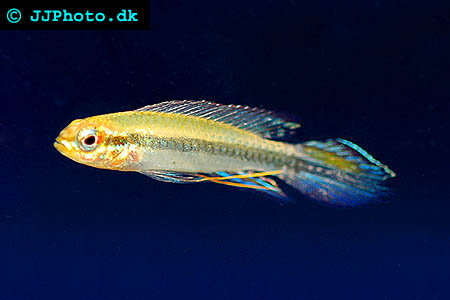Taeniacara candidi
Taeniacara candidi is a dwarf cichlid closely related to the more famous Apistogramma cichlids. Earlier, Taeniacara candidi was actually considered to be an Apistrogramma cichlid and went by the name Apistogramma weisei, but it has now been moved to the genus Taeniacara. Taeniacara candidi inhabits the Amazon River basin. Its native habitat is located in the lower Rio Negro and along the Rio Amazon to Rio Tapajós.
Sexing Taeniacara candidi
You can distinguish males from females by looking at the tale fin; the male Taeniacara candidi has a spade-shaped tail. The males will also sport longer pectoral fins than the females. Both sexes are slim compared to Apistogramma cichlids and males normally distinguish themselves from females by being bigger. Adult Taeniacara candidi males can grow up to 7 cm, while females normally stay around 5 cm. When it comes to coloration, the male sports a jet-black stripe from the tail fin to the front of his eyes. The caudal, anal, and ventral fins can be of many different colors, including red, blue, yellow and brown.
Coaxing Taeniacara candidi to spawn
Taeniacara candidi should not be used to cycle aquariums; ideally use an aquarium that has been up and running for several months and where the environment is stable. Decorate the aquarium with drift wood and plants, e.g. Java Fern and Water Sprite, to make the fish feel secure. You can for instance use Java Fern. Oak leaves are very popular, especially in aquariums without any substrate. Remember to pre-soak the leaves, otherwise they will not sink. Add a suitable spawning site, such as a flower pot placed upside down in the aquarium.
The recommended water temperature for breeding Taeniacara candidi is 27-28 degrees C. The water should be as soft as possible. If your tap water is hard, collect rainwater and use for the aquarium. The pH-value should be kept below pH 5.5. Some breeders use dilute phosphoric acid to achieve this. Using oak leaves and filtering the water through peat moss is another alternative.
Large amounts of live food is known to induce breeding in Taeniacara candidi; you can for instance give your fish mosquito larvae, white worms, and chopped earth worms.

Taeniacara candidi
Picture added to article by Ac tropical fish. Copyright www.jjphoto.dk
Breeding Taeniacara candidi
In the beginning of the breeding period, the males will chase each other around a bit to establish who the dominant one is. The female will chose a spawning site and this is where the actual spawning will take place. You can let the egg stay in the aquarium with the adult fish because the parents will patrol the area and fend off intruders. Sometimes they will be so efficient that the other aquarium inhabitants get really scared and refrain from eating. If this happens, you may want to consider moving the non-parents to another aquarium. One way of avoiding this problem is to give the couple their own breeding aquarium before they spawn.After about a 7-12 days, the fry will be large enough to follow their mother out from the spawning site. They will feed on algae in the aquarium, so prolific algae growth should be encouraged when breeding Taeniacara candidi. Supplement the algae with microworms and newly hatched brine shrimp to ensure a varied diet. When kept on a nutritious diet, Taeniacara candidi fry can reach a size of 10 mm within a month.
Didn't find the info you were looking for? Register for free and ask your question in our Aquarium forum !
Our knowledgeable staff usually responds to any question within 24 hours
Related Articles
Apistogramma panduro - Keeping and breeding Apistogramma panduroApistogramma sp. Maulbrüter - The Mouthbrooding Apistogramma - This fish is a delayed mouthbrooder, mouthbrooding the fry rather than the eggs.
Apistogrammas My Way - Setting up the tank. The spawning. Reverse osmosis water. New species.
Breeding Apistogramma njesseni - Breeding Apistogramma njesseni
Breeding the African Butterfly Cichlid, Anomalochromis thomasi - This small riverine cichlid from West Africa is easy to breed and raise, even in a community setting.
Dicrossus filamentosa - Information about how to keep and breed checkerboard cichlids.
Dwarf Crenicichla - Information about Dwarf Crenicichla
Dwarf Pike Cichlids - how to keep and breed dwarf pike cichlids
Jewel cichlid - Information about Jewel cichlid
Jeweled cichlids - Information about Jeweled cichlids
Keeping And Breeding Microgeophagus altispinosa (The Bolivian Ram) - The Bolivian Ram is easy to breed.
Pelvicachromis taeniatus "Nigeria green" - A guide to keeping and breeding this fancy krib.
The Genus Apistogramma - Information about how to keep and breed apistogramma species in aquariums.
Fish News
Aquarium Forum
Calculators
Free Aquarium Ebook
Feedback
Fish Anatomy
Link to us
Photo gallery
Plant species
Tropical fish species
By Common name
By Scientific name
Tropical Marine fish
By Common name
By Scientific name
Algae Control
Aquarium Decoration
Aquarium Resources
Aquatic Plants
Barb Fish
Betta Fish
Breeding Fish
Catfish
Central American Cichlids
Cichlids
Clownfish
Corals
Corydoras Catfish
Discus Fish
Dwarf Cichlids
Fish Diseases
Frogs and Turtles
Goby Fish
Goldfish
Gourami
Invertebrates
Jellyfish
Killiefish
Lake Victoria Cichlids
Livebearers
Malawi Cichlids
Marine Aquariums
Marine Aquarium Fish
Other Fish
Pleco
Predatory Fish
Photography
Pond Fish
Responsible Fish Keeping
Rainbow Fish
Shark Fish
South American Cichlids
Tanganyika Cichlids
Tetra Fish
Tropical Fish Food
